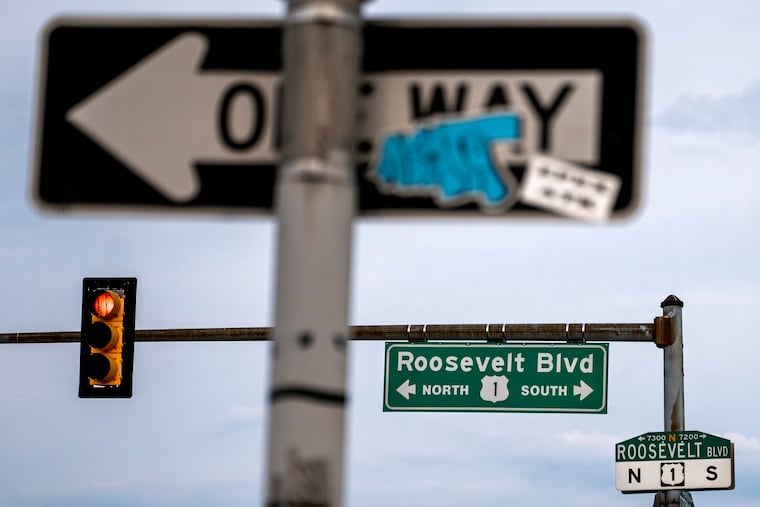Roosevelt Boulevard subway talk has moved from ‘impossible’ to how to pay for it
One idea floated for financing rail rapid transit on the Boulevard: tolls on its express lanes for motor vehicles.

Imagine a Roosevelt Boulevard subway connecting Northeast Philadelphia and Lower Bucks County to the rest of the city and region, financed in part by new tolls on the thoroughfare’s express lanes.
That’s one funding possibility advocates are discussing with elected leaders and transportation officials to make the proposal real, including during a meeting Monday with state Transportation Secretary Mike Carroll, SEPTA chief executive Leslie S. Richards and City Councilmember Michael Driscoll, who represents a district in the Northeast.
“The tolls would pay off construction bonds,” said Jay Arzu, a University of Pennsylvania doctoral student in urban planning who has been campaigning for the project for about 18 months.
Building rapid rail transit from the Northeast to Center City has been a part of regional transportation plans since 1913. It’s been considered and then dismissed over the years, often because of the cost.
Lately, the idea seems to be getting serious deliberation again, despite SEPTA’s budget woes and stiff competition for the billions of federal dollars newly available for transport infrastructure.
“It’s an immense project, and it’s likely going to be a many years’ process before it can be built,” said Jacob Golden, legislative director for Driscoll, the member of City Council. “We need to figure out how to pay our share.”
Supporters of the Northeast rail line are pitching it as an engine of economic growth, a means to better knit the region together, and a way to reduce motor-vehicle traffic on one of the nation’s most dangerous urban roadways.
Arzu said Carroll, the state transportation secretary, told subway advocates at Monday’s meetings that a formal proposal would have to be fiscally responsible. PennDot is working on a new feasibility study, following two analyses completed more than 20 years ago.
Earlier this year, Richards said SEPTA saw “no way forward” on the boulevard subway because of an estimated cost of at least $7 billion and the agency’s tight capital budgets, which are smaller than other large transit systems with more robust regional tax support.
But in a meeting with the Editorial Board of The Inquirer last week, Richards referred to the subway extension as she discussed the transit agency’s need for sustained support from the governments of Philadelphia and its four suburban counties. That support is needed to raise the local-match funds SEPTA needs to land more federal grants.
“We have some exciting conversations about Roosevelt Boulevard, but none of that will become a reality unless we can increase these local matches — and not just in the millions; we’re talking in the billions — in order for us to get some [more] new projects done,” Richards said.
Pennsylvania lawmakers are considering two bills that would authorize cities and counties to increase some fees and taxes to raise money for regional transit systems. Reps. Joe Hohenstein and Ben Waxman, both Philadelphia Democrats, are sponsoring the proposals.
In March, SEPTA canceled its proposed King of Prussia rail project, a short extension of the Norristown High Speed Line, after the Federal Transit Administration rejected it for funding because it would not have served enough riders.
The June collapse of an I-95 bridge in the Northeast brought attention to the subway proposal, and City Council voted to hold public hearings on it, expected in October. Behind the scenes, Arzu, Driscoll, State Rep. Jared Solomon (D., Phila.) and volunteers have met with members of the region’s congressional representatives, business and civic group in the Northeast and Bucks County leaders, drumming up support for the subway.
The 1913 proposal, under Mayor Rudolph Blankenburg, was to build an elevated train line along the length of Roosevelt Boulevard. A surface light-rail line and a subway have also been considered — the latter as an extension of the Broad Street Line with a mile-long spur connecting Bustleton to the Market-Frankford Line.
In 2003, a study for Philadelphia and SEPTA planners by six engineering and design firms estimated such a subway extension in the median of the roadway could be built within 10 years for about $3 billion.
By 2021, the Route for Change report on the future of Roosevelt Boulevard, prepared by the city, SEPTA, and PennDot, recommended bus rapid transit with separate lanes by 2040 and offered two alternative designs: a $10.8 billion partially capped expressway that would have dedicated rapid bus lanes, protected bike lanes, and local traffic on the surface; and a $1.9 billion plan for a slower-speed roadway with dedicated bus lanes, flex lanes (which could be used for on-street parking in nonpeak hours), and bike lanes.
And now rail is back on the agenda.
“The momentum is not going to die down,” Arzu vowed.